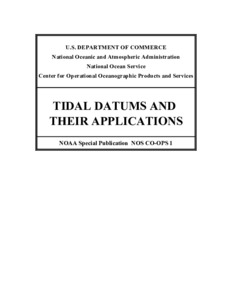| dc.contributor.editor | Gill, Stephen K. | |
| dc.contributor.editor | Schultz, John R. | |
| dc.date.accessioned | 2018-12-21T23:59:08Z | |
| dc.date.available | 2018-12-21T23:59:08Z | |
| dc.date.issued | 2001 | |
| dc.identifier.citation | Gill, S.K. and Schultz, J.R. (eds) (2001) Tidal datums and their applications. Silver Spring MD, NOAA, NOS Center for Operational Oceanographic Products and Services, 102pp. & Appendix. (NOAA Special Publication NOS CO-OPS 1). DOI: http://dx.doi.org/10.25607/OBP-170 | en_US |
| dc.identifier.uri | http://hdl.handle.net/11329/607 | |
| dc.identifier.uri | http://dx.doi.org/10.25607/OBP-170 | |
| dc.description.abstract | The United Nations declared 1998 to be the
International Year of the Ocean. This
declaration provides an opportunity to rais
e public awareness of a fundamental boundary
defined by the intersection of the ocean with th
e land. This intersection is not as simple as
it may seem. It is determined by a plane called
a tidal datum, and refers to an average height
of the water level at particular phases of the
tidal cycle. This vertical reference surface is
derived from water level measurements record
ed along coastlines, estuaries, and tidal rivers
of the United States. Tidal datum planes, refe
renced to a system
of bench marks, are
fundamental to the determination of the spatial coordinates of latitude, longitude, and
elevation relative to mean sea level.
Tidal datums are chiefly used to determine horizontal boundaries, and for estimating
heights or depths. The legal determinations
of private and public lands, state owned tide
lands, state submerged lands, U.S. Navigable wa
ters, U.S. Territorial Sea, Contiguous Zone,
and Exclusive Economic Zone, and the High Seas, or international waters, depend on the
determination of tidal datums and their survey
ed intersection with the coast. Navigation in
U.S. Harbors, shipping channels, and intraco
astal waterways requires an accurate knowledge
of the depth of the ocean and submerged hazards
at the low-water phase of the tidal cycle.
Passage underneath bridges requires knowledge of
the clearance at the high water phase of
the tide. In addition, coastal construction
and engineering requires knowledge of the tidal
cycle; significant wave heights, periods, and directions; the heights of storm surges, or
tsunami waves; and, the frequency and horizont
al extent of flooding in the coastal zone.
Organizing these environmental data into mean
ingful, decision-making contexts requires the
establishment of tidal datums, and their reference to the geodetic control network.
Other countries publish tidal datums that ma
y differ significantly from those of the U.S.
In fact, there are hundreds of local datums used
throughout the world. This has led to efforts
to define a global vertical datum. The ellipso
id serves as a suitable candidate because of its
horizontal and vertical accuracy, its relative ease of calculation, and its global accessibility
via GPS. A set of vertical transformation f
unctions are required to translate the vertical
coordinate provided by GPS into a
coordinate referenced to a tidal datum plane. Preliminary
research suggests promising results in the c
onstruction of a seamless vertical reference
system.
This document has been prepared by NOAA’
s Center for Operational Oceanographic
Products and Services Division
to provide background information about tidal datum planes.
The chapters present overviews of the histor
y of tidal datums in the U.S., domestic and
international legal regimes, water level measurement system and bench marks, derived
products available from NOAA, and examples of
the practical and legal applications of tidal
datums. | en_US |
| dc.language.iso | en | en_US |
| dc.publisher | NOAA, NOS Center for Operational Oceanographic Products and Services | en_US |
| dc.relation.ispartofseries | NOAA Special Publication NOS CO-OPS;1 | |
| dc.rights | CC0 1.0 Universal | * |
| dc.rights.uri | http://creativecommons.org/publicdomain/zero/1.0/ | * |
| dc.subject.other | Tidal datum | en_US |
| dc.title | Tidal datums and their applications. | en_US |
| dc.type | Report | en_US |
| dc.description.status | Published | en_US |
| dc.format.pages | 102pp. & Appendix | en_US |
| dc.description.notes | Contributors:
Wolfgang Scherer, William M. Stoney, Thomas N. Mero, Michael O’Hargan,
William Michael Gibson, James R. H
ubbard, Michael I. Weiss, Ole Varmer,
Brenda Via, Daphne M. Frilot, Kristen A. Tronvig. | |
| dc.description.refereed | Refereed | en_US |
| dc.publisher.place | Silver Spring, MD | en_US |
| dc.subject.parameterDiscipline | Parameter Discipline::Physical oceanography::Sea level | en_US |
| dc.rights.license | Public Domain | |
| dc.description.currentstatus | Current | en_US |
| dc.description.eov | Sea surface height | en_US |
| dc.description.bptype | Best Practice | en_US |
| dc.description.bptype | Guide | en_US |
| obps.contact.contactemail | coops.webmaster@noaa.gov | |
| obps.resourceurl.publisher | https://tidesandcurrents.noaa.gov/pub.html | en_US |
 Repository of community practices in Ocean Research, Applications and Data/Information Management
Repository of community practices in Ocean Research, Applications and Data/Information Management

